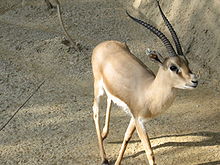Rhim gazelle
| Rhim gazelle | |
|---|---|
 |
|
| Scientific classification | |
| Kingdom: | Animalia |
| Phylum: | Chordata |
| Class: | Mammalia |
| Order: | Artiodactyla |
| Family: | Bovidae |
| Subfamily: | Antilopinae |
| Genus: | Gazella |
| Species: | G. leptoceros |
| Binomial name | |
|
Gazella leptoceros (F. Cuvier, 1842) |
|
The rhim gazelle (Gazella leptoceros), also known as the slender-horned gazelle or sand gazelle, is a slender-horned gazelle, mostly adapted to desert life. It is listed as Endangered because fewer than 2500 are left in the wild. These gazelles are found in Algeria, Chad, Egypt, Libya and Sudan.
Growing to a length of 101 to 116 cm (40 to 46 in), this is the palest of the gazelles, and well adapted to desert life in many ways. The upper parts are pale buff or cream and the limbs and under parts white or pale buff. The horns on the male are slender and slightly S-shaped; those of the female are even thinner, lighter and nearly straight. There are faint facial markings and an indistinct stripe along the side. The tail is brownish-black, about 15 cm (6 in) long, and contrasts with the pale rump.
The rhim gazelle is known from Algeria, Tunisia, Libya and Egypt. It has also been reported from Niger and Chad, but these sightings seem doubtful and its precise range is unclear. The rhim gazelle is found in isolated pockets across the central Sahara Desert. The extreme heat of this environment limits their feeding to the early morning and evening, and G. leptoceros gains most of its water requirements from dew and plant moisture, relying little on open water sources. The rhim gazelle is a nomadic species, moving across its desert range in search of vegetation, though it does not have a set migratory pattern. Its typical habitat is sand dunes and the depressions between them and other sandy areas, but also rocky areas.
Endangered by the early 1970s, this species of gazelle was in serious decline. They were hunted firstly by mounted then by motorized hunters for sport, meat, or their horns, which were sold as ornaments in North African markets. The threats the animals face now include poaching, disturbance by humans and loss of suitable habitat. The International Union for Conservation of Nature estimates there may only be 300 to 600 mature individuals in the wild, and has rated their conservation status as "endangered".
On February 1, 1987, the Libyan General Posts and Telecommunications Company, in cooperation with World Wide Fund for Nature, issued a set of four postage stamps illustrating Gazella leptoceros.
...
Wikipedia

